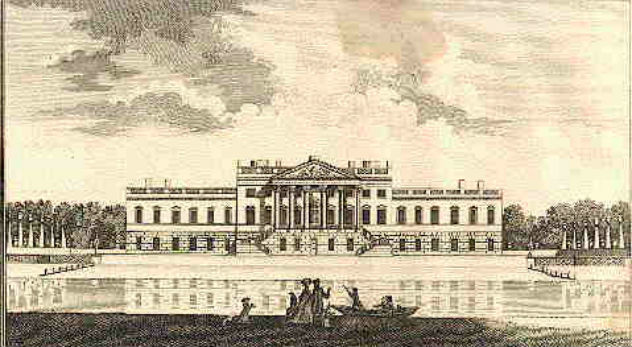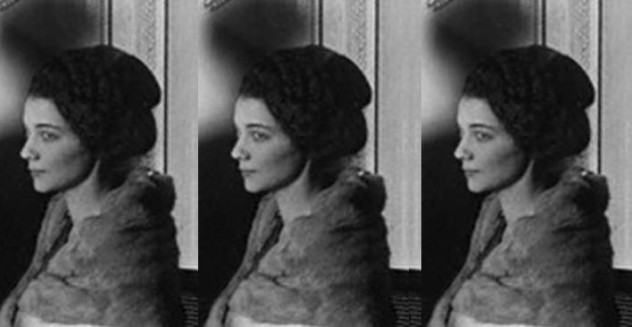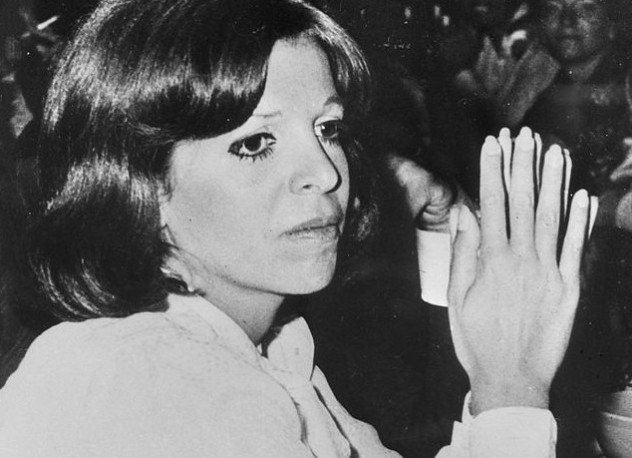 Mysteries
Mysteries  Mysteries
Mysteries  Creepy
Creepy 10 Scary Tales from the Middle Ages That’ll Keep You up at Night
 Humans
Humans 10 One-of-a-kind People the World Said Goodbye to in July 2024
 Movies and TV
Movies and TV 10 Holiday Movies Released at Odd Times of the Year
 Politics
Politics 10 Countries Where Religion and Politics Are Inseparable
 Weird Stuff
Weird Stuff 10 Freaky Times When Famous Body Parts Were Stolen
 Miscellaneous
Miscellaneous 10 Interesting Things Manufacturers Stopped Making and Why
 Gaming
Gaming 10 Funny Tutorials in Games
 History
History 10 Fascinating Little-Known Events in Mexican History
 Facts
Facts 10 Things You May Not Know about the Statue of Liberty
 Mysteries
Mysteries 10 Devastating Missing Child Cases That Remain Unsolved
 Creepy
Creepy 10 Scary Tales from the Middle Ages That’ll Keep You up at Night
 Humans
Humans 10 One-of-a-kind People the World Said Goodbye to in July 2024
Who's Behind Listverse?

Jamie Frater
Head Editor
Jamie founded Listverse due to an insatiable desire to share fascinating, obscure, and bizarre facts. He has been a guest speaker on numerous national radio and television stations and is a five time published author.
More About Us Movies and TV
Movies and TV 10 Holiday Movies Released at Odd Times of the Year
 Politics
Politics 10 Countries Where Religion and Politics Are Inseparable
 Weird Stuff
Weird Stuff 10 Freaky Times When Famous Body Parts Were Stolen
 Miscellaneous
Miscellaneous 10 Interesting Things Manufacturers Stopped Making and Why
 Gaming
Gaming 10 Funny Tutorials in Games
 History
History 10 Fascinating Little-Known Events in Mexican History
 Facts
Facts 10 Things You May Not Know about the Statue of Liberty
10 Wealthy Heiresses You Don’t Want To Trade Places With
The cliche might be tired and worn out, but it still rings true most of the time: Riches won’t buy you happiness. Or protect you from misfortune. Women born into wealth seem particularly vulnerable to the curse of having too much money. Is all that luxury and privilege worth it? Okay, now go ahead and scratch that lottery ticket.
10 Georgia Inman
Georgia and her twin brother, Walker Patterson, are children of Walker Inman Jr., a troubled, drug-addicted multimillionaire who inherited his fortune from tobacco heiress Doris Duke. For children set to inherit a reported $1 billion when they turn 21, they were horrifyingly neglected, undernourished, and undereducated. Their miserable childhood was a struggle for survival.
Their father had a penchant for destruction and considered blowing things up a form of therapy after the twins’ mother, Daisha, left him. He shot up his horse racing arena in South Carolina with a machine gun. Georgia’s stepmom, Daralee, was also an addict and alcoholic who nearly killed the twins and herself in a DUI episode.
Inman allegedly treated his children like prisoners, locking them up in the cellar or in their bedroom. The kids had to relieve themselves in a corner. A pile of uneaten and rotting food added to the stench. In fact, the entire house was a foul drug den. It got so bad that Georgia remembers once creeping up to her father as he slept and holding a gun to his head.
People who saw the twins were shocked by their emaciated appearance. They suffered from serious speech delays and couldn’t hold a pencil or crayon properly. Inman told them that Daisha had given the kids fetal alcohol syndrome, making them “retarded.” It was part of his campaign of slurs and innuendos against Daisha as they fought a bitter custody battle.
When Inman died in 2010, Daisha picked up her twins to live with her. But by now, they had been traumatized and were suicidal. They had to be sent to the Wyoming Behavioral Institute. Daralee contends that all their stories of abuse were planted into their heads by Daisha, but independent testimony has proven that the twins were largely telling the truth.
Free of the abuse at last, the twins must wage another battle—for their inheritance. The banks who hold the trusts wouldn’t tell the exact amount, and the Inmans have demanded an accounting. Raids by Inman and others have allegedly reduced the funds to $60 million. “People can look at this as a blessing all day long, but it’s blood money,” Georgia said.
“I never asked to be born into any of this,” she adds. “Sometimes I wish I was never born.”
9 Catherine Tylney-Long

Catherine Tylney-Long’s greatest mistake was to reward persistence. None other than the nephew of the Duke of Wellington, William Wellesley-Pole, proposed to her six times. Catherine gave in on the seventh. William turned out to be a worthless husband.
A petite beauty known as “the pocket Venus,” Catherine inherited the family fortune upon the death of her 10-year-old brother James. Just 16 years old, Catherine was worth £300,000 and was celebrated as the richest commoner in early 19th-century Britain. Her palatial home, Wanstead House, sat magnificently on a beautifully landscaped park, long the scene for fashionable balls and gatherings. It was not surprising that Catherine was followed around by a bevy of suitors, hovering around her like attendants.
Aware that her riches were as much the focus of male attention as her beauty, Catherine was ever careful to discern her suitors’ real motives. Fear of the fortune hunter kept Catherine single until she was 22. That was when she brought into her life the very fate she had tried to avoid.
William Wellesley-Pole was a known troublemaker, irresponsible and anti-authoritarian. Having lost a lot of money and deep in debt, he determined that marrying a rich woman was his ticket out. He set his sights on Catherine. It remains a mystery why she finally succumbed, as it appears that her decision to marry William was made against her better judgment. Perhaps in a foreshadowing of the future, William forgot the wedding ring when they were married on March 14, 1812.
William lost little time in helping himself to his wife’s fortune. He gambled and hosted extravagant stag hunts and lavish parties from which Catherine was excluded. A failed and expensive political campaign drained even more money. In 10 years, William had dissipated the Tylney fortune and was £250,000 in debt. Wanstead Park was auctioned off, and William fled from his creditors to the Continent.
Catherine and her three children took shelter with her family in Wiltshire. There, she heard of William’s affair with another woman. Humiliated, she sought divorce and tried to keep her children away from her husband. Catherine fell ill, possibly from venereal disease she contracted from the promiscuous William. Her dying wish was for her children never to see their father again. Catherine died on September 12, 1825. She was 35. Her ghost reputedly wanders around Wanstead Park.
8 Abigail Folger
The daughter of Folger Coffee Co. chairman Peter Folger was simply at the wrong place at the wrong time. Abigail Folger was at Sharon Tate’s Bel-Air mansion the night when Charles Manson’s Family commenced their killing spree.
Born on August 11, 1943, Abigail showed talent in painting and music, earning a degree in Art History from Harvard. In 1967, she took a job at the University of California art museum at Berkeley. As with most people born into wealth, Abigail felt something missing in her life and went in search for it. In a short while, she had given up her job in Berkeley and headed to New York, where she worked for a magazine publisher and then at a bookstore.
A Polish author friend introduced Abigail to Wojchiech Frykowski, and a romance soon developed. In summer 1968, the couple moved to California. In Los Angeles, Abigail finally found her calling as a volunteer social worker for the LA County Welfare Department, doing rounds among the children at the Watts ghetto. She attended fundraisers for the Haight-Ashbury Medical Clinic at around the same time the Manson women were being treated there. “I’ve never been involved in anything so exciting in my life,” Abigail told a friend. “I finally have something real to live for.”
At the same time, Abigail’s wealth, intelligence, and beauty gained her ready acceptance into the Hollywood glamor set, which included actress Sharon Tate and her director and husband Roman Polanski. But Abigail’s work (and the helplessness she felt at the massive social problems of the inner city) pushed her along the path of exhaustion and depression. It didn’t help matters that her relationship with Wojchiech was beginning to sour. Abigail turned to drugs.
On the fateful night of August 8, 1969, Abigail and Wojchiech joined Sharon Tate and Jay Sebring at Miss Tate’s Cielo Drive home. Abigail was in a bedroom reading when Susan Atkins barged in with a buck knife and ordered her to join her three companions in the living room. There, the murderous rampage started when Charles “Tex” Watson began stabbing Sebring. Abigail struggled with Patricia Krenwinkel and managed to escape despite being knifed repeatedly. Krenwinkel and Watson caught up with her on the lawn, continuing to stab maniacally.
According to her killers, Abigail begged them to stop the attack, saying, “I give up, you’ve got me,” and, “I’m already dead.” Abigail was just three days shy of her 26th birthday.
7 Eva Rausing
Eva was the wife of Hans Kristian Rausing, Swedish heir to the £4.5 billion Tetra-Pak packaging company fortune. On the surface, the couple lived in leisure and luxury, hobnobbing with European royalty in a whirl of society parties. But Eva and Hans led a double life. While they donated to charities dedicated to fighting drug addiction, they themselves were hooked on substance abuse.
It was an addiction that had haunted both for decades. In fact, Hans and Eva Kemeny met in a rehab clinic in the US in the 1990s. American-born Eva was the daughter of a wealthy businessman, Pepsi executive Tom Kemeny. As a university student in California, she already led a troubled life, dropping out and not returning to school until she was 24. Eva managed to eke out an economics degree.
Eva’s marriage to Hans, whose family was ranked the 12th-richest in Britain, produced four children. Eva lived the typical bored lifestyle of the super-rich. “I don’t work, but probably should,” she admitted. “Or at least think of a constructive way of using my time, enlarging my life.” We can only speculate what role this played in her descent, but after years of being clean, Eva found herself slipping: “I fell back into the same hole as before and have been there for nearly seven years.” Meanwhile, Hans was also experiencing a relapse.
A hint that all was not well surfaced in 2008 when Eva was caught with heroin and crack cocaine while on the way to a US Embassy reception. Photographs of the couple showed them looking disheveled and undernourished, but no one read the clues. The Rausings continued to support many anti–drug abuse and other charities. But when one trustee commented that “We all agree we don’t like drugs,” Eva replied, “No, I love drugs. That’s the problem.” But she was hopeful of turning her life around. “I once read that I would have seven bad years (I don’t normally believe in hocus pocus horoscopes) but so far it has been right, and I’m hoping for seven good years starting 2007,” she wrote on MySpace. It was not to be.
On July 9, 2012, police stopped Hans for driving erratically. He was found to be in possession of Class A drugs. In a search of the Rausing’s mansion in London’s exclusive Belgravia district, they found Eva’s decomposing body in the bedroom. She had been dead for two months from a drug overdose. The £70 million home had been transformed into a squalid drug den. Hans and Eva spent the last months living in just two messy rooms. Hans was arrested for delaying the burial of a dead body.
One acquaintance suggested that Eva might not have died had authorities went ahead and prosecuted her for drug possession in the US Embassy incident.
6 Henrietta Guinness

People believe that a dark curse is stalking the Guinness family of famous Anglo-Irish brewers. Beginning with the dynasty’s founder Arthur Guinness in the 18th century, bizarre and tragic fates have hounded his descendants. This curse was particularly cruel to Henrietta Guinness.
Lady Henrietta despised the riches she was born into and set to inherit. “If I had been poor, I would have been happy,” she once said. She adopted a footloose lifestyle to escape her stifling environment and fell in with London’s Chelsea crowd. She horrified her family with the way she spent her money on her friends. Henrietta bought a £28,000 Belgravia restaurant for an Italian chef she had planned to marry and gave away her £70,000 salon to her hairdresser. The wedding didn’t push through, though Henrietta had already converted to Catholicism to marry the chef.
In 1963, Henrietta planned to elope with “Britain’s best-known beatnik,” Michael Beeby. He was driving Henrietta in her Aston Martin in the French Riviera when they crashed, seriously injuring both. Henrietta never did recover from the mental and physical effects of the accident. Her spiraling depression required hospitalization.
It seemed Lady Henrietta had found peace at last when she moved to Spoleto, Italy, and married a poor medical school dropout, Luigi Marinori, then working as a bartender. She bore him a daughter, Sarah. The Marinoris moved into a humble cottage, and Henrietta settled down to domestic tranquility.
But her demons had followed her. No one would ever know what dark force it was that, on May 3, 1978, impelled her to climb up the famous Ponte delle Torri bridge and jump to her death 60 meters (200 ft) below. She was just 35 years old.
5 Alice de Janze

American heiress Alice de Janze was dangerous with a gun. But did she really kill her ex-lover Lord Erroll? Some believe she may have gotten away with murder. Nevertheless, Alice could not escape the day of reckoning brought on by her decadent lifestyle.
Alice was born to business royalty. Her father, William Edward Silverthorne, made his fortune in the textile industry. Her mother, Julia Belle Chapin, was related to the Armour meatpacking family. Julia died of tuberculosis when Alice was eight, and William, too busy with his business and booze to raise his daughter, left Alice to a governess while he got himself a new wife. During her teen years, William returned to educate Alice on the pleasures of Chicago’s nightclubs and the indulgent pastimes of high society.
In Paris, the 22-year-old Alice met Frederic Jacques, Comte de Janze, and they were married after three weeks. They had two children, whom they promptly turned over to the usual governesses, while they joined the notoriously debauched Happy Valley crowd of rich, white colonials. Drugs, drunkenness, sex parties, and adultery were the scandalous staples of the group based in Kenya. In fact, Alice was more caring of animals than of her children. She kept a pet lion cub and had a Nile crocodile in her bathtub.
Alice and Frederic divorced in 1926 over her affair with the Englishman Raymond Vincent de Trafford. When Raymond’s family threatened to cut him off over the relationship, he tried to break up with her. In a rather melodramatic public display of crime passionnel, Alice pulled out a revolver and shot Raymond, then herself, as they sat on a train in Paris. Both survived, and thanks to wealth, connections, and the peculiar French sympathy for crimes of passion, Alice got off with only a fine and a suspended sentence. Amid a shocked public, Raymond and Alice were wed in 1932. The union was all over in just three months.
Now suffering from depression, Alice returned to Kenya where the sunshine cheered her up somewhat. But it wouldn’t last long. When her ex-lover Lord Erroll, who was having an affair with a much younger woman, was found shot dead in his car near Nairobi in 1941, Alice became a suspect. Eventually, Sir Henry Broughton was tried for the crime but was acquitted. The murder remains unsolved, but a case can be made that Alice was the real murderess.
When Alice was diagnosed with uterine cancer later that year, she found some barbiturates to overdose on. She was discovered and rescued by her friend Patricia Bowles, but Alice succeeded in turning her gun on herself a week later.
4 Anne Scripps-Douglas

It has always been a puzzle to her closest friends what drew Anne Scripps, great-great-granddaughter of The Detroit News founder James Scripps, to hot-tempered high school dropout Scott Douglas. It was a mismatch from the start, and the mild-mannered Anne would pay with her life.
Anne was raised in affluence and privilege, attending exclusive all-girls Catholic schools and coming of age in debutante balls in New York and Vienna. In 1969, she married Wall Street bond salesman Anthony Morell and had two daughters, Alexandra and Annie. Anne preferred the simple life and enjoyed the quiet of being a mother and generally being a homebody—the complete opposite of Anthony, who loved parties. The couple divorced after 19 years.
In distress and afraid of being alone, Anne was vulnerable to the flattery of the attractive house painter Scott Douglas when they met at a Super Bowl party in 1989. Months later, much to the dismay of Anne’s family, she married Scott. Her folks considered him not very bright and articulate, and Alexandra and Annie thought him crude. Others thought the debonair but secretive Scott was a “chameleon.” Nevertheless, all was well in the beginning, and Anne gave birth to daughter Victoria.
Gradually, Scott became mean, controlling, and very critical of Anne. He reportedly never mentioned he was married to co-workers and female friends and hung around with the ladies when away from home. Anne refused his demand for a joint bank account and a new BMW. By this time, the $900 million Scripps fortune was paying Anne $10,000 a month. Arguments about money escalated, and Scott’s drunken rages battered Anne. Once, Scott nearly pushed her out of a moving car. Terrified of what Scott would do to her and her daughter, Anne got a temporary restraining order from the court, but Scott wasn’t evicted from the home, and Anne chose not to move out. It was a fateful decision.
On New Year’s Eve 1993, Scott beat Anne in the head repeatedly with the claw end of a hammer. He then drove to the center span of the Tappan Zee Bridge, pulled over, and jumped to his death. Anne held on for a few days before succumbing to her injuries.
A grief-stricken Anthony Morell, now dying of cirrhosis, wept at her bedside. In a bizarre twist of fate, Anthony would survive by having Anne’s liver transplanted into him.
3 Barbara Hutton
Barbara Hutton was insanely rich from both sides of her family. Her maternal grandfather, Frank W. Woolworth, lorded over an empire of retail stores worth $65 million ($900 million in today’s values) at its prime. Equally successful was the New York investment bank E.F. Hutton, which was co-founded by her father, Franklyn Laws Hutton. It is hard to believe that Barbara would die virtually broke, a divorcee seven times over.
Born in 1912, Barbara was the original “poor little rich girl.” Her father was a cheater, driving her mother to suicide when Barbara was only six. Discovering her mother’s body made a deep impression on the child.
Franklyn was hardly there for his daughter, and Barbara was shunted back and forth among relatives and governesses. She wasn’t denied the best money could buy, however, and her lavish coming-out party when she turned 18—in the midst of the Great Depression—cost $60,000 (around $1 million today). The resulting public indignation at such excess resulted in Barbara’s escape from media attention to Europe.
By age 21, Barbara was worth $50 million. Lacking her grandfather’s business sense, she spent her inheritance recklessly. But all the money in the world couldn’t buy her marital happiness. Her sad choices for husbands included a baron, three princes, a count, and a notorious playboy to whom she was hitched for a total of 53 days. Most were only after her money and carried home hefty sums from the divorce settlements. She had an only son, Lance, from her second husband, the abusive Count Curt Heinrich Eberhard Erdmann Georg von Haugwitz-Hardenberg-Reventlow, who had her switch to Danish citizenship for tax reasons. He was arrested when his unrelenting physical abuse landed Barbara in the hospital.
The only husband who may have truly cared for Barbara and not her money was her third, actor Cary Grant, whom she wed in 1942. Though the press dubbed them “Cash and Cary,” Grant received nothing when the pair divorced three years later. The pangs of Barbara’s emotional hunger was by now leading her to anorexia fed by a diet of barbiturates. Her spending escalated to epic proportions—jewelry, art, palatial mansions. “If you’ve got it, flaunt it,” Barbara said. Woolworth employees, weary of Barbara’s irresponsible splurges while they struggled with their paychecks, went on strike, yelling, “Is 18 dollars a week too much?”
Barbara’s once-vast fortune inevitably dwindled. She began liquidating assets and watched her properties and possessions go to pay off debts. Her son, Lance, was killed in a plane crash in 1972. Barbara spent her last years in a Beverly Hills hotel, where she succumbed to a heart attack in 1979 at 66. She was down to her last $3,500.
2 Evalyn Walsh McLean
Heiress of mining tycoon Tom Walsh, socialite Evalyn Walsh McLean was the last private owner of the Hope Diamond, notorious for its curse. Renowned in Washington, DC, circles as a charming hostess, Evalyn did not believe in curses. She was enraptured by the 44.5-carat diamond, a gift from her husband Edward “Ned” McLean. Evalyn made it a point to wear the Hope with her Parisian outfits at her lavish parties to be admired by the guests.
But even before the diamond came into her life, Evalyn had her share of tragedies. Her brother Vinson was killed in a car accident in which Evalyn herself was also seriously injured. It took many agonizing months before her broken leg healed, and she became addicted to morphine in the process. Evalyn weaned herself away from the painkiller, only to relapse upon the death of her father. But for a second time, Evalyn made a comeback.
On a visit to the Ottoman Sultan Abd-Al Hamid, Evalyn first beheld the Hope Diamond, worn by the sultan’s favorite in the harem. The accursed stone had purportedly left a trail of victims since it was removed from the eye of a Hindu idol, a list that included Marie Antoinette. The sultan himself was later overthrown by a revolution. More likely, the story of the curse was cooked up by the jeweler Pierre Cartier, who had acquired the rock and hoped the romantic backstory would entice Evalyn to buy it. Cartier was right. Evalyn was mesmerized. Ignoring warnings from friends, she had Ned buy the Hope Diamond for $180,000. From that moment, Evalyn said, “I . . . hooked my life to its destiny for good or evil.”
Soon after, Evalyn’s nine-year-old firstborn son Vinson—once called the “$100 million baby”—was killed in a car accident. Ned ran off with another woman and spent their fortune willy-nilly. The family newspaper, the Washington Post, went bankrupt, forcing Evalyn to part with some properties. Ned, a chronic alcoholic, died in a sanatorium. Finally in 1946, Evalyn’s 25-year-old daughter died from an overdose of sleeping pills. With every misfortune, the curse of the Hope Diamond was blamed.
But Evalyn, who considered the Hope her good luck charm, was dismissive of the curse. “What tragedies have befallen me might have occurred had I never seen or touched the Hope Diamond. My observations have persuaded me that tragedies, for anyone who lives, are not escapable.”
Evalyn died in 1947. The Walsh mansion in Washington, now the Indonesian Embassy, is reportedly haunted by Evalyn’s nude ghost.
1 Christina Onassis

“She was one of those people who would never be happy,” Henrietta Gelber said of her stepsister, Christina Onassis. “She would become impatient. It had all come too easily—all the money, houses all over the world, few real responsibilities.” What Christina craved was love and companionship, to live like a normal human being. She died without ever enjoying what most of us take for granted.
Born in 1950, Christina was the only daughter of Greek shipping magnate Aristotle Onassis. As a child, she played with dolls dressed by Dior and ponies presented by King Ibn-Saud of Saudi Arabia. Christina never received much attention from her parents, who broke up over Aristotle’s affair with opera singer Maria Callas. In another turn of events, her father married former US First Lady Jacqueline Kennedy, whom Christina distrusted and disliked. Their relationship would remain icy throughout her life.
Within the short span from 1973 to 1975, Christina lost all her closest family members—her older brother Alexander in a plane crash, her mother from either drug overdose or pulmonary edema, and lastly, her father. “I’m all alone in the world now,” Christina lamented.
Christina hated being alone, but she didn’t choose her friends and husbands wisely. None of Christina’s four marriages lasted more than two years. As each marriage ended, Christina would sink into depression with nothing to motivate her. She struggled to lose weight and began taking amphetamines and barbiturates.
With her fourth husband, Thierry Roussel, Christina bore daughter Athina. Roussel left them both in 1987, but Christina doted on Athina, bringing her the same luxuries she had as a child. Christina always worried about Athina being kidnapped and had a nurse and two bodyguards tag along whenever they went out.
Having taken over the Onassis shipping empire on Aristotle’s death, Christina proved to be an efficient business manager, but she still lacked a sense of achievement. She also resented the interference her stepmother Jackie was bringing into business affairs. Jackie managed to take control over much of the organization.
After her separation from Roussel, Christina flew to Buenos Aires with Athina, intending to start a new life. She stayed with friends and was reportedly in high spirits. On November 19, 1988, Christina was found dead in the bathroom, apparently of heart attack brought on by her drug habit.
Larry is a freelance writer whose main interest is history.








